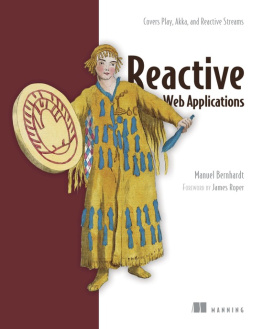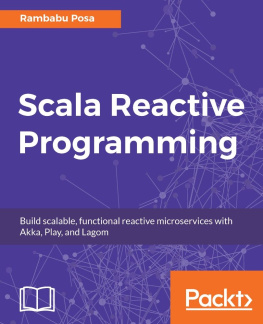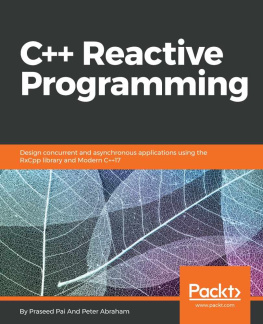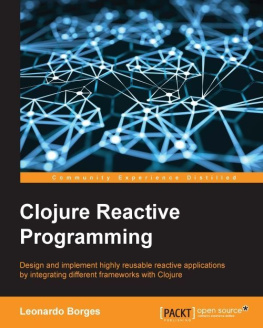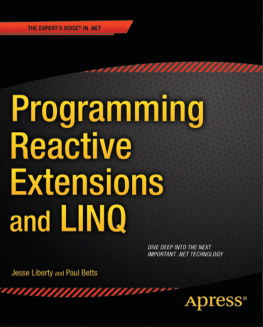Manuel Bernhardt - Reactive Web Applications
Here you can read online Manuel Bernhardt - Reactive Web Applications full text of the book (entire story) in english for free. Download pdf and epub, get meaning, cover and reviews about this ebook. year: 2016, publisher: Manning Publications, genre: Computer. Description of the work, (preface) as well as reviews are available. Best literature library LitArk.com created for fans of good reading and offers a wide selection of genres:
Romance novel
Science fiction
Adventure
Detective
Science
History
Home and family
Prose
Art
Politics
Computer
Non-fiction
Religion
Business
Children
Humor
Choose a favorite category and find really read worthwhile books. Enjoy immersion in the world of imagination, feel the emotions of the characters or learn something new for yourself, make an fascinating discovery.
- Book:Reactive Web Applications
- Author:
- Publisher:Manning Publications
- Genre:
- Year:2016
- Rating:4 / 5
- Favourites:Add to favourites
- Your mark:
- 80
- 1
- 2
- 3
- 4
- 5
Reactive Web Applications: summary, description and annotation
We offer to read an annotation, description, summary or preface (depends on what the author of the book "Reactive Web Applications" wrote himself). If you haven't found the necessary information about the book — write in the comments, we will try to find it.
Reactive Web Applications — read online for free the complete book (whole text) full work
Below is the text of the book, divided by pages. System saving the place of the last page read, allows you to conveniently read the book "Reactive Web Applications" online for free, without having to search again every time where you left off. Put a bookmark, and you can go to the page where you finished reading at any time.
Font size:
Interval:
Bookmark:

For online information and ordering of this and other Manning books, please visit www.manning.com. The publisher offers discounts on this book when ordered in quantity. For more information, please contact
Special Sales Department Manning Publications Co. 20 Baldwin Road PO Box 761 Shelter Island, NY 11964 Email: orders@manning.com2016 by Manning Publications Co. All rights reserved.
No part of this publication may be reproduced, stored in a retrieval system, or transmitted, in any form or by means electronic, mechanical, photocopying, or otherwise, without prior written permission of the publisher.
Many of the designations used by manufacturers and sellers to distinguish their products are claimed as trademarks. Where those designations appear in the book, and Manning Publications was aware of a trademark claim, the designations have been printed in initial caps or all caps.
 Recognizing the importance of preserving what has been written, it is Mannings policy to have the books we publish printed on acid-free paper, and we exert our best efforts to that end. Recognizing also our responsibility to conserve the resources of our planet, Manning books are printed on paper that is at least 15 percent recycled and processed without the use of elemental chlorine.
Recognizing the importance of preserving what has been written, it is Mannings policy to have the books we publish printed on acid-free paper, and we exert our best efforts to that end. Recognizing also our responsibility to conserve the resources of our planet, Manning books are printed on paper that is at least 15 percent recycled and processed without the use of elemental chlorine.
 | Manning Publications Co.20 Baldwin RoadPO Box 761Shelter Island, NY 11964 |
ISBN 9781633430099
Printed in the United States of America
1 2 3 4 5 6 7 8 9 10 EBM 21 20 19 18 17 16
Until four years ago, every major web application that I had written used the tried-and-trusted thread-per-request execution model. A few niche applications that I had been involved witha chat server and a push notification systemmay have used some form of evented I/O, but I would have laughed at the suggestion that that model should be used for general web development. At that time in our industrys history, the word reactive was virtually unheard-of.
The switch to reactive applications has been the biggest architectural change since the web itself, and it has swept across our industry at lightning speed. What I considered far-fetched four years ago, I now use every day, and I am lead developer of Play, a framework that embraces it. With the concept evolving from relative obscurity to mainstream best practice in such a short time, its no wonder that countless web developers are asking the question, What is reactive? This is where Reactive Web Applications perfectly fills a gap.
Beginning with addressing the question of why we need reactive in the first place, Manuel takes you through the principles of reactive development as it applies to web applications, in the context of the practical grounding of the Play Framework, Akka, and Reactive Streams. Youll be guided through concrete examples and exercises, and youll come away with a solid understanding of how reactive web applications are architected, developed, tested, and deployed, so you can try it out yourself.
The journey to reactive applications is one in which were all continually learning. The Reactive Manifesto itself has undergone several revisions in the short time since my colleagues first penned it. Manuel and I have attended many conferences together, and weve chatted often in person and through our dealings in open source software about how reactive development should be realized in web applications. Im glad to see that Manuel has so articulately captured these leading-edge best practices for web application development in this time of great change in our thinking. The practical application of this book to web development will put you in a great position to produce software for the high demands of todays world.
J AMES R OPER
L EAD DEVELOPER OF THE P LAY F RAMEWORK
I first had the idea for this book in April 2014, after Id spent the better part of four months assisting a client rebuild their entire application infrastructure using Scala, the Play Framework, and Akka, three technologies Id already been using extensively for a few years.
The existing application faced two challenges that called for a rebuild: On one hand, the application data was spread across two separate database systems, a few caches, and a few external cloud services such as Amazon EC2, YouTube, SoundCloud, and Mixcloud, making it nearly impossible to keep the data up to date and in sync. On the other hand, the number of users had been increasing, and the flood of requests whenever a new campaign was launched had started to overwhelm the system. It was almost unavailable under load. The new version of the application had to accommodate sudden bursts in traffic in its initial design. And to make things more interesting, the relaunch of the site not only involved migrating, reconsolidating, and updating the data of millions of users and tens of millions of items, but it had to happen over a single weekend.
This project is a perfect example of a new category of web applicationsone that has gained increasing importance over the past few years. Reactive web applications need to be able to cope with a varying and potentially large numbers of requests, manage and provide access to large datasets, and communicate with several cloud services in real time. To make things more complicated, all of these tasks need to be carried out while withstanding the inevitable failures that occur in an increasingly complex networked environment. Gone are the days when all of a web applications data was hosted on the same computer or in the same data centera scenario that often hid the true and messy nature of computer networks. Reactive web applications rely heavily on heterogeneous and distributed services, but paradoxically the margin for user-facing errors is smaller than ever. The tolerance of todays typical user is close to zero. Everyone is used to the service reliability of giants such as Google or Facebook, unaware of the tremendous technical challenges faced by the engineers building and operating these platforms.
Building reactive web applications is no small feat, and it wouldnt be possible without the advances in technology weve witnessed over the past few years. Reactive technologies enable asynchronous programming coupled with first-class failure handling. The Play Framework and the Akka concurrency toolkit are two technologies that combine to offer a solid foundation for building reactive web applications. They both leverage the powerful functional programming concepts provided by the Scala programming language, enabling asynchronous and reactive programming.
This book aims to be a guide to using Scala, the Play Framework, Akka, and a few more powerful and exciting technologies to build reactive web applications. In one way, its the book I wish I had when starting to work with this stack several years ago. I hope youll find it useful and wish you a fun ride while reading it!
You wouldnt be holding this book in your hands today if it werent for the support, insights, inspiration, encouragement, and feedback from a whole lot of people. To everyone involved: thank you!
Font size:
Interval:
Bookmark:
Similar books «Reactive Web Applications»
Look at similar books to Reactive Web Applications. We have selected literature similar in name and meaning in the hope of providing readers with more options to find new, interesting, not yet read works.
Discussion, reviews of the book Reactive Web Applications and just readers' own opinions. Leave your comments, write what you think about the work, its meaning or the main characters. Specify what exactly you liked and what you didn't like, and why you think so.

